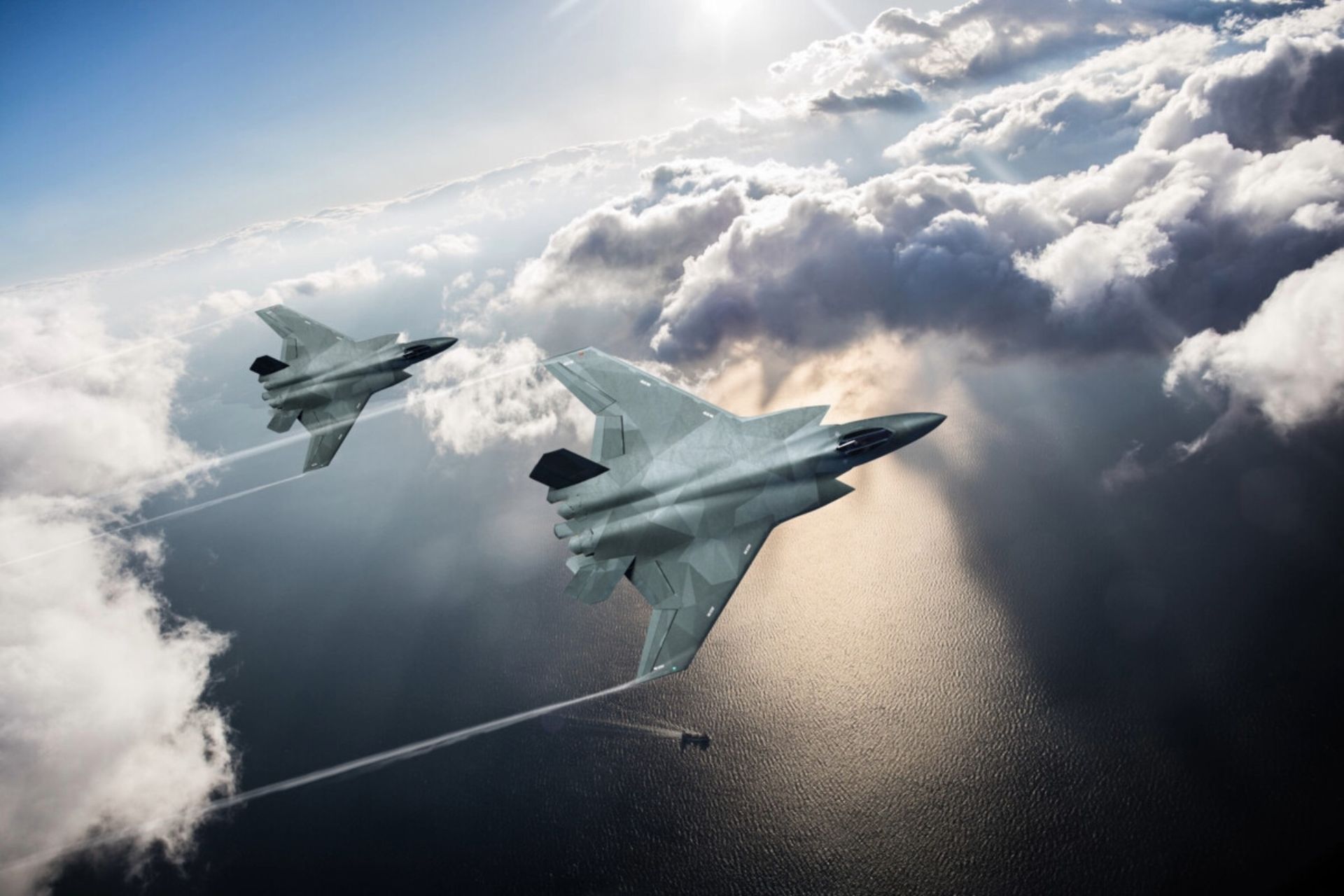Tempest Reaches Important Milestone: Progress Review
BAE Systems reveals demonstrator design for GCAP future fighter

Tempest Takes Flight: A New Era for UK Aerospace
The UK's ambitious sixth-generation fighter jet, Tempest, has recently marked a pivotal milestone with the commencement of manufacturing for its demonstrator aircraft. This development is not merely a step forward for a single aircraft; it heralds a new era for advanced combat aviation and brings significant implications for the aerospace sector, including in the South East of England.
The Journey So Far: From Concept to Construction
The strategic concept development for what would become Tempest began as early as 2015. The project was officially launched at the Farnborough International Airshow in July 2018, as part of the UK Ministry of Defence's (MoD) Combat Air Strategy, with an initial commitment of £2 billion in government funding up to 2025. Industry partners pledged an additional £800 million.
By late 2021, the Future Combat Air System (FCAS) project, with BAE Systems as the lead contractor, entered its Concept and Assessment phase. A major announcement in July 2022 confirmed that a technology demonstrator aircraft was planned to fly within five years, aiming for 2027. This demonstrator, the first crewed supersonic combat demonstrator developed in the UK in over 40 years, is now actively undergoing manufacturing and assembly of its main structure. More than half of the aircraft's weight, including the fuselage and wings, is already in production, with some sources stating two-thirds of the structural weight is being manufactured. Test pilots from BAE Systems, Rolls-Royce, and the Royal Air Force (RAF) have already logged over 300 hours of simulated flights in a high-fidelity simulator, providing crucial design insights well ahead of the first physical flight. The Tempest is slated to enter service with the Royal Air Force around 2035, gradually replacing the Eurofighter Typhoon.
A Glimpse into the Future: Revolutionary Innovations
Tempest is designed to be a "sixth-generation" fighter, signifying a leap in capabilities far beyond current aircraft like the F-35. Key innovations planned for the jet include:
- An Airborne Supercomputer: The aircraft will be a "system of systems," extensively networked with various assets, including loyal wingman drones. It will be powered by advanced AI-driven software and Machine Learning, enabling the system to exploit information for maximum weapon effect.
- Optionally Manned: Tempest is planned to be optionally manned, capable of remote flight for specific missions, reflecting ongoing debates about the future of military aircraft. It may also feature gesture control and eye-tracking to measure pilot workload, fatigue, and mental stress when manned.
- Lasers and Advanced Power Generation: The jet is expected to be armed with lasers and Electronic Warfare (EW) non-kinetic effectors, which will provide a valuable tool in layered defence. Rolls-Royce is developing next-generation engines that will provide significantly increased electrical power generation capability – ten times the output of current Typhoon engines – coupled with an intelligent power management system. This system will also be optimised for thermal management, using the gas-turbine as a heat 'sink' to recycle thermal energy and improve efficiency.
- Advanced Radars and Sensors: The Tempest will feature integrated sensing with systems like the ISANKE (Integrated Sensing and Non-Kinetic Effects) and ICS (Integrated Communications Systems) suite. Its radar is projected to gather 10,000 times more data than current systems, providing a significant battle advantage. This data will be processed by powerful on-board computers and linked to a "combat cloud" architecture with adaptive, ultra-fast cyber-resilient datalinks.
- Modular and Adaptable Design: The aircraft will be modular, with an open systems architecture, allowing for easy role adaptation, simple component upgrades, and rapid integration of new technologies throughout its service life.
- Range and Payload Prioritisation: Recent design changes, including a significantly larger wing with a modified delta planform, suggest the design is optimised for long range and a large internal payload. This is critical for accommodating internal ordnance, a common drawback for stealth aircraft.
- 3D Printing and Digital Manufacturing: BAE Systems plans to use additive manufacturing (3D printing) for approximately 30% of Tempest's structure, producing primary structural components. This includes creating mold tools for carbon fibre components in three weeks, compared to 26 weeks with traditional methods. This approach significantly reduces manufacturing time and waste, contributing to the project's ambitious development timeline. Furthermore, individual parts from retired Tornado aircraft have been ground down and 3D printed into new components for the Tempest programme, demonstrating an innovative recycling project.
A Global Endeavour: The Collaborative Core
The Tempest is not a solo venture but the centerpiece of the Global Combat Air Programme (GCAP), a trilateral partnership involving the United Kingdom, Italy, and Japan. This international collaboration aims to share the immense industrial and technological burden. The prime contractors leading their national contributions are BAE Systems (UK), Leonardo (Italy), and Mitsubishi Heavy Industries (Japan). A joint company, Edgewing, has been established with BAE Systems, Leonardo, and Japan Aircraft Industrial Enhancement Co. Ltd (JAIEC) each holding a 33.3% share.
Within the UK, the core partners for "Team Tempest" include the MoD, BAE Systems (leading systems integration), Rolls-Royce (power and propulsion), Leonardo UK (sensors, electronics, avionics), and MBDA UK (weapons). This group works with hundreds of other UK firms and academic institutions in the wider supply chain. While Sweden initially explored collaboration, it has since moved to a more observational role. There is also interest from other nations, notably Saudi Arabia, in joining the programme.
The collaborative model seeks to leverage diverse expertise and share costs, addressing the rising expenses of combat aircraft development. However, multinational projects can face challenges, including potential for delays and cost overruns due to differing national requirements and priorities. Italy’s defence minister has recently claimed that the UK is not fully sharing technologies with Italy and Japan, calling for "barriers of selfishness" to be brought down. Despite this, the UK MoD affirms that GCAP is a "leading example of the strength of joint programmes".
Boosting the South East's Aerospace Future
While much of the core manufacturing for Tempest is concentrated in the North West of England, particularly at BAE Systems' Warton site in Lancashire, the project has a tangible presence and significant implications for the aerospace sector in the South East of England.
A major development is the establishment of the Global Combat Air Programme (GCAP) headquarters in Reading, Berkshire, in the South East of England. Opened in July 2025 by Minister for Defence Procurement Maria Eagle, this new facility in Green Park is intended to be a "centre of excellence, uniting top talent from our three governments and industries". It is expected to create around 100 jobs initially. This signifies a crucial strategic and collaborative hub for the entire international programme located within the region.
Furthermore, Leonardo, a key partner in Team Tempest, has established a network of data-enabled digital factories across its UK sites, including one in Luton, which is also in the South East of England. These digital factories are crucial for developing technologies for next-generation sensing and communications, as well as advanced open-system architectures. The widespread application of digital engineering and Industry 4.0 technologies, fundamental to Tempest's development, will likely lead to broader benefits and skills development across regions hosting project sites.
The broader Tempest programme is already a significant job creator, supporting 3,500 UK jobs and 1,000 apprenticeships. Initiatives like "Generation Tempest" are actively promoting Science, Technology, Engineering, and Mathematics (STEM) careers and providing upskilling opportunities across the UK, including through involvement with UK universities. This commitment to nurturing a new generation of engineers and technologists will have long-term benefits for the UK's high-tech industries, including those in the South East, ensuring a skilled workforce for future innovations.
In essence, the Tempest project, with its cutting-edge innovations and international collaborative structure, is set to redefine the future of air combat and significantly bolster the UK's aerospace capabilities. The establishment of the GCAP headquarters in Reading and the presence of digital innovation hubs like Leonardo's facility in Luton underscore the South East's critical role in the project's strategic and technological advancement, promising a robust future for the region's aerospace sector.
Note 1: The Role of Rolls-Royce Engines
The Tempest fighter jet will be powered by two next-generation engines developed by Rolls-Royce. Rolls-Royce is a core partner in the Team Tempest consortium, specifically responsible for advanced power and propulsion systems.
Key details about the engines and power systems include:
- Next-Generation Design: The engines are being developed to provide significantly increased electrical power generation capability, projected to be ten times the output of current Typhoon engines. This is critical for supporting the aircraft's advanced systems, including powerful radars, electronic warfare (EW) non-kinetic effectors, and laser weapons.
- Integrated Systems: Rolls-Royce is developing an optimised Thermal Management System that will utilise the gas turbine as a heat 'sink' to recycle thermal energy, improving overall system efficiency and removing the need for overboard venting. An intelligent power management system will be coupled with the increased electrical power generation to meet the high demands of the air vehicle.
- Embedded Starter Generator: A revolutionary aspect is the plan to build an embedded starter generator directly into the engine core, removing the need for a bulky external gearbox and saving space, weight, and complexity. Early tests for this program, dubbed E2SG, began in 2014.
- International Collaboration: Rolls-Royce is collaborating with Japan's IHI Corporation to develop and deliver a future fighter engine demonstrator, bringing together complementary British and Japanese technologies.
- Demonstrator Engines: For the current crewed combat air demonstrator, which is undergoing manufacturing, two EJ200 engines (donated by the Ministry of Defence) are being prepared for installation. These engines, from the Eurofighter Typhoon, are for the prototype to test concepts and potential, and are not the actual engines being developed for the eventual operational aircraft. This approach mirrors the Experimental Aircraft Programme (EAP) that preceded the Typhoon, which used proven engines for early testing.
- Orpheus Demonstrator: Rolls-Royce has also developed a demonstrator engine known as Orpheus, which supports the rapid development and production of key future engine capabilities. Parts from retired Tornado aircraft have been recycled and 3D printed into new components, such as a nose cone and compressor blades, for the Orpheus test engine, demonstrating a novel recycling project.
The advanced power and propulsion system is designed to enable the Tempest to maintain its stealth signature by managing heat and providing ample electricity for its sophisticated onboard electronics and potential high-energy weapons.
Note 2: The Demonstrator Details
The demonstrator aircraft plays a pivotal and multi-faceted role in advancing the UK's future combat air strategies, both technologically and strategically. It is designed to de-risk the ambitious Tempest programme and validate key innovations before full production.
Here's how the demonstrator contributes:
- Testing and Validating Cutting-Edge Technologies:
- The demonstrator is a piloted supersonic aircraft specifically designed to test a wide range of new technologies, including stealth-compatible features and next-generation flight controls.
- It will provide crucial data on aerodynamics, stealth coatings, engine performance, and avionics.
- Innovations like additive manufacturing (3D printing) are being used to produce significant structural parts, demonstrating efficient and cost-effective production methods. This includes the recycling of parts from old Tornado aircraft, which are 3D printed into new components for the demonstrator's engine, showcasing potential for savings and reduced reliance on global supply chains.
- It supports the development of future integrated sensing and non-kinetic effects (ISANKE) and integrated communication systems (ICS) architectures by integrating hardware, software, and enabling architectures onto a flying test-bed.
- Digital weapon integration processes are being trialled with the demonstrator, aiming to reduce the time and cost associated with weapons integration.
- Rolls-Royce is supplying EJ200 engines for the demonstrator, allowing for successful integration testing for power and propulsion.
- De-Risking and Accelerating Development:
- The demonstrator is "essential for de-risking future aircraft development". This is a knowledge-based approach, aimed at ensuring that core technologies are sufficiently mature before proceeding with full-scale development, contrasting with issues seen in other major projects like the F-35.
- It helps to "significantly reduce the time and cost involved in building future military jets" through the use of digital techniques such as model-based systems engineering, digital twins, 3D printing, cobotics, and immersive simulation.
- Test pilots have already logged over 300 hours in high-fidelity simulators, providing vital insights for design and familiarization well ahead of the first physical flight. This allows for virtual testing to confirm models and potentially reduce the need for hundreds of costly physical test flights.
- The rapid progress on the demonstrator contributes to the ambitious goal of an in-service date of 2035, which is significantly shorter than previous combat air programmes.
- Maintaining Sovereign Capability and Skills:
- The demonstrator is a "vital initiative for developing national skills and advanced technology", ensuring the UK remains a world leader in the design, production, test, and certification of combat aircraft.
- It helps to "equip our people with the skills they will need to deliver GCAP", fostering a new generation of engineers and technologists for the digitisation of the programme.
- This project is the first crewed supersonic combat demonstrator developed in the UK in over 40 years, signifying a revival of the UK's industrial capability in combat aircraft.
- By maintaining the UK's ability to design, build, and support advanced military aircraft, it reinforces the commitment to operational independence and reduces reliance on single partners, such as the United States.
- Facilitating International Collaboration:
- The demonstrator is a "UK sovereign effort" but the lessons learned will be fed back into the tri-national Global Combat Air Programme (GCAP) involving the UK, Italy, and Japan.
- Its existence and progress can help convince other nations of the programme's viability, potentially attracting new partners, especially if rival projects face delays.
- It demonstrates the industrial strengths and comparative advantages of the partner nations.
In essence, the demonstrator is not merely a test vehicle; it is a foundational element that underpins the entire Tempest/GCAP endeavour, validating the most challenging aspects of the next-generation fighter's design, manufacturing, and operational concepts, while simultaneously nurturing the essential skills and industrial base for the UK's future in aerospace.
Event Registration Form
EVENT BOOKING
Terms & Conditions
Your information will be used solely by FAC for the purposes of managing your participation in this event and providing you with relevant updates. It may also be forwarded to attendees of the event for the purpose of collaboration unless you specify on the form your objection.
Terms : By signing this form you understand you are committing to this event and agree to the FAC Terms. Cancellation must be received 2 weeks before an event for a refund. Less than 2 weeks we are committed to costs and therefore the full amount will stand.
A registration form must be completed for you to attend any event






